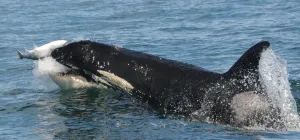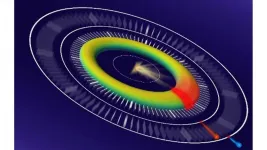(Press-News.org) The source of potentially hazardous solar particles, released from the Sun at high speed during storms in its outer atmosphere, has been located for the first time by researchers at UCL and George Mason University, Virginia, USA.
These particles are highly charged and, if they reach Earth's atmosphere, can potentially disrupt satellites and electronic infrastructure, as well as pose a radiation risk to astronauts and people in airplanes. In 1859, during what's known as the Carrington Event, a large solar storm caused telegraphic systems across Europe and America to fail. With the modern world so reliant on electronic infrastructure, the potential for harm is much greater.
To minimise the danger, scientists are seeking to understand how these streams of particles are produced so they can better predict when they might affect Earth.
In the new study, published in Science Advances, researchers analysed the composition of solar energetic particles heading towards Earth, and found they had the same "fingerprint" as plasma located low in the Sun's corona, close to the middle region of the Sun's atmosphere, the chromosphere.
Co-author Dr Stephanie Yardley (UCL Mullard Space Science Laboratory, MSSL) said: "In our study we have observed for the first time exactly where solar energetic particles come from on the Sun. Our evidence supports theories that these highly charged particles originate from plasma that has been held down low in the Sun's atmosphere by strong magnetic fields. These energetic particles, once released, are then accelerated by eruptions that travel at a speed of a few thousand kilometres a second.
"Energetic particles can arrive at Earth very quickly, within several minutes to a few hours, with these events lasting for days. Currently, we can only provide forecasts of these events as they are taking place, as it is highly challenging to predict these events before they occur. By understanding the Sun's processes better we can improve forecasts so that, when a major solar storm hits, we have time to act to reduce risks."
Lead author Dr David Brooks (George Mason University and Honorary Associate Professor at UCL MSSL) said: "Our observations provide a tantalising glimpse into where the material that produces solar energetic particles comes from in a few events from the last solar cycle. We are now starting a new solar cycle, and once it gets going we will use the same techniques to see if our results are generally true, or if these events are somehow unusual.
"We are lucky in that our understanding of the mechanisms behind solar storms and solar energetic particles is likely to advance quickly over coming years thanks to data that will be gained from two spacecraft - ESA's Solar Orbiter and the NASA Parker Solar Probe - that are heading closer to the Sun than any spacecraft has been before."
In the study, researchers used measurements from NASA's Wind satellite, located between the Sun and Earth, to analyse a series of solar energetic particle streams, each lasting at least a day, in January 2014. They compared this to spectroscopy data from the JAXA-led Hinode spacecraft. (The EUV Imaging Spectrometer onboard the spacecraft was built by UCL MSSL and Dr Brooks is a member of the mission's Operations Team in Japan.)
They found that the solar energetic particles measured by the Wind satellite had the same chemical signature - an abundance of silicon compared to sulphur - as plasma confined close to the top of the Sun's chromosphere. These locations were at the "footpoints" of hot coronal loops - that is, at the bottom of loops of magnetic field and plasma extending out into the Sun's outer atmosphere and back again.
Using a new technique, the team measured the coronal magnetic field strength at these footpoints, and found it was very high, in the region of 245 to 550 Gauss, confirming the theory that the plasma is held down in the Sun's atmosphere by strong magnetic fields ahead of its release into space.
Solar energetic particles are released from the Sun and are accelerated by solar flares (large explosions) or coronal mass ejections - ejections of huge clouds of plasma and magnetic field. About 100 solar energetic particle events occur every 11-year solar cycle, although this number varies from cycle to cycle.
The latest findings support the idea that some solar energetic particles originate from a different source than the slow solar wind (the origin of which is still debated), as they are confined in specific conditions in hot coronal loops at the core of the source region. A faster solar wind is emitted continuously by the Sun; its encounter with the Earth's atmosphere can generate the Northern Lights.
The high-energy particles released in January 2014 came from a volatile region of the Sun which had frequent solar flares and CMEs, and an extremely strong magnetic field. The region, known as 11944, was one of the largest active regions on the Sun at the time and was visible to observers on Earth as a sunspot - a dark spot on the surface of the sun*.
A strong radiation storm alert was issued at the time by the NOAA / NWS Space Weather Prediction Center but the solar energetic particle event is not known to have caused any disruption within the Earth's atmosphere, although computer systems on the Hinode spacecraft itself recorded several particle hits.
A measurement was taken of the magnetic field strength within the region 11944 in a separate study shortly after this time-period, and was one of the highest ever recorded in the Sun - 8.2kG.
INFORMATION:
The researchers were funded by the NASA Hinode programme and UKRI.
A huge volume of digital data has been harvested, stored and shared in the last few years - from sources such as social media, geolocation systems and aerial images from drones and satellites - giving researchers many new ways to study information and decrypt our world. In Switzerland, the Federal Statistical Office (FSO) has taken an interest in the big data revolution and the possibilities it offers to generate predictive statistics for the benefit of society.
Conventional methods such as censuses and surveys remain the benchmark for generating socio-economic indicators at the municipal, cantonal and national levels. But these methods can now be supplemented with secondary, mostly pre-existing data, from sources such as cell-phone ...
More than five years after receiving an experimental immunotherapy drug, half of a group of people at high risk of developing Type 1 diabetes remained disease-free compared with 22% of those who received a placebo, according to a new trial overseen by Yale School of Medicine researchers.
And those who developed diabetes did so on average about five years after receiving the new drug, called teplizumab, compared with 27 months for those who received the placebo.
The study, which was done in collaboration with researchers from Indiana University, was published March 3 in the journal Science Translational Medicine.
"If approved for use, this will be the first drug to delay or prevent Type 1 diabetes," ...
A series of nanoparticle-based vaccines elicits protective antibodies against various strains of the influenza virus in nonhuman primates, according to work from Nicole Darricarrère and colleagues. Although more research is needed, the vaccines mark an important step toward a universal flu vaccine for humans, which has long been a major goal for infectious disease researchers. Current seasonal flu vaccines can prevent disease but often only work for a year, after which a new vaccine must be developed. This occurs because influenza viruses evolve extremely quickly, meaning that a year-old vaccine may not prepare the immune system to recognize a new ...
Endangered Southern Resident killer whales prey on a diversity of Chinook and other salmon. The stocks come from an enormous geographic range as far north as Alaska and as far south as California's Central Valley, a new analysis shows.
The diverse salmon stocks each have their own migration patterns and timing. They combine to provide the whales with a "portfolio" of prey that supports them across the entire year. The catch is that many of the salmon stocks are at risk themselves.
"If returns to the Fraser River are in trouble, and Columbia River returns are strong, then prey availability to the whales potentially balances out ...
Scientists from the Skoltech Center for Design, Manufacturing and Materials (CDMM) and the Institute for Metals Superplasticity Problems (IMSP RAS) have studied the fatigue behavior of additive-manufactured high-entropy alloys (HEA). The research was published in the Journal of Alloys and Compounds.
Conventional 20th century materials that are extensively used in industries and mechanical engineering have reached their performance limit. Nowadays, alloying is commonly used to improve the alloys' mechanical performance and increase their operating temperature. ...
Coastal communities at the forefront of climate change reveal valuable approaches to foster adaptability and resilience, according to a worldwide analysis of small-scale fisheries by Stanford University researchers.
Globally important for both livelihood and nourishment, small-scale fisheries employ about 90 percent of the world's fishers and provide half the fish for human consumption. Large-scale shocks -- like natural disasters, weather fluctuations, oil spills and market collapse -- can spell disaster, depending on the fisheries' ability to adapt to change. In an assessment of 22 small-scale fisheries that experienced stressors, researchers revealed that diversity and flexibility are among the most important adaptive capacity factors ...
Humans were present in Florida by 14,000 years ago, and until recently, it was believed the Bahamas - located only a few miles away - were not colonized until about 1,000 years ago. But new findings from a team including a Texas A&M University at Galveston researcher prove that the area was colonized earlier, and the new settlers dramatically changed the landscape.
Peter van Hengstum, associate professor in the Department of Marine and Coastal Environment Science at Texas A&M-Galveston, and colleagues have had their findings published in PNAS (Proceedings of the National Academy of Sciences).
Researchers generated a new ...
A detailed analysis of mental health treatment trends during the COVID-19 pandemic found a 7% increase in visits during the initial shelter-in-place period in 2020, compared with the same 3-month period in 2019.
The study, published in The Journal of Clinical Psychiatry March 3, examined patient visits for psychiatric diagnoses among members of Kaiser Permanente in Northern California.
The greatest increases in visits were for substance use (up 51%), adjustment disorder (up 15%), anxiety (up 12%), bipolar disorder (up 9%), and psychotic disorder (up 6%). Adjustment disorder is diagnosed when someone responds ...
Breakthrough greatly enhances the ultrafast resolution achievable with X-ray free-electron lasers.
A large international team of scientists from various research organizations, including the U.S. Department of Energy's (DOE) Argonne National Laboratory, has developed a method that dramatically improves the already ultrafast time resolution achievable with X-ray free-electron lasers (XFELs). It could lead to breakthroughs on how to design new materials and more efficient chemical processes.
An XFEL device is a powerful combination of particle accelerator and laser technology producing extremely brilliant and ultrashort pulses of X-rays for scientific research. "With this technology, scientists can now track processes that occur within millions of a billionth of ...
HOUSTON - (March 3, 2021) - In one of the first studies of its kind, an analysis of camera-trap data from 15 wildlife preserves in tropical rainforests has revealed a previously unknown relationship between the biodiversity of mammals and the forests in which they live.
Tropical rainforests are home to half of the world's species, but with species going extinct at a rapid pace worldwide, it's difficult for conservationists to keep close tabs on the overall health of ecosystems, even in places where wildlife is protected. Researchers found that observational data from camera traps can help.
"In general, rainforest ecosystems ...



